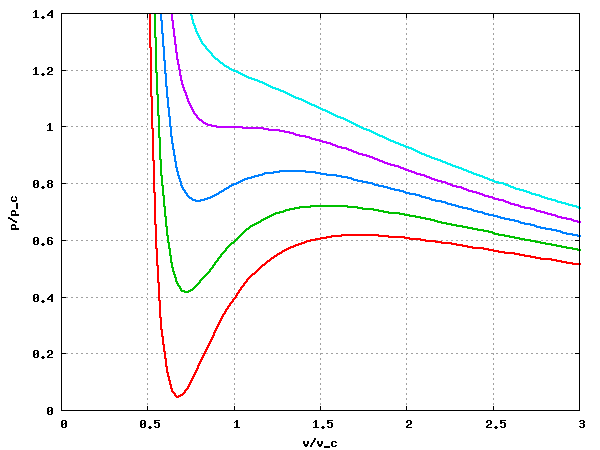Van der Waals equation of state: Difference between revisions
mNo edit summary |
Carl McBride (talk | contribs) m (Slight re-arrangement of page.) |
||
| Line 1: | Line 1: | ||
The '''van der Waals equation of state''', developed by [[ Johannes Diderik van der Waals]], can be written as | The '''van der Waals equation of state''', developed by [[ Johannes Diderik van der Waals]], takes into account two features that are absent in the [[Equation of State: Ideal Gas | ideal gas]] equation of state; the parameter <math> b </math> introduces somehow the repulsive behavior between pairs of molecules at short distances, | ||
it represents the minimum molar volume of the system, whereas <math> a </math> measures the attractive interactions between the molecules. The van der Waals equation of state leads to a liquid-vapor equilibrium at low temperatures, with the corresponding critical point. | |||
==Equation of state== | |||
The van der Waals equation of state can be written as | |||
:<math> \left. p = \frac{ n R T}{V - n b } - a \left( \frac{ n}{V} \right)^2 \right. </math>. | :<math> \left. p = \frac{ n R T}{V - n b } - a \left( \frac{ n}{V} \right)^2 \right. </math>. | ||
| Line 5: | Line 8: | ||
where: | where: | ||
* <math> p </math> is the [[pressure]], | * <math> p </math> is the [[pressure]], | ||
* <math> V </math> is the volume, | * <math> V </math> is the volume, | ||
* <math> n </math> is the number of moles, | * <math> n </math> is the number of moles, | ||
* <math> T </math> is the absolute [[temperature]], | * <math> T </math> is the absolute [[temperature]], | ||
* <math> R </math> is the [[molar gas constant]]; <math> R = N_A k_B </math>, with <math> N_A </math> being the [[Avogadro constant]] and <math>k_B</math> being the [[Boltzmann constant]]. | * <math> R </math> is the [[molar gas constant]]; <math> R = N_A k_B </math>, with <math> N_A </math> being the [[Avogadro constant]] and <math>k_B</math> being the [[Boltzmann constant]]. | ||
:<math>a= \frac{27}{64}\frac{R^2T_c^2}{P_c}</math> | :<math>a= \frac{27}{64}\frac{R^2T_c^2}{P_c}</math> | ||
:<math>b= \frac{RT_c}{8P_c}</math> | :<math>b= \frac{RT_c}{8P_c}</math> | ||
| Line 39: | Line 34: | ||
The following image is a plot of the isotherms <math>T/T_c</math> = 0.85, 0.90, 0.95, 1.0 and 1.05 (from bottom to top) for the Van der Waals equation of state: | The following image is a plot of the isotherms <math>T/T_c</math> = 0.85, 0.90, 0.95, 1.0 and 1.05 (from bottom to top) for the Van der Waals equation of state: | ||
[[Image:vdW_isotherms.png|center|Plot of the isotherms T/T_c = 0.85, 0.90, 0.95, 1.0 and 1.05 for the Van der Waals equation of state]] | [[Image:vdW_isotherms.png|center|Plot of the isotherms T/T_c = 0.85, 0.90, 0.95, 1.0 and 1.05 for the Van der Waals equation of state]] | ||
==Maxwell's equal area construction== | |||
==Interesting reading== | ==Interesting reading== | ||
*J. D. van der Waals "Over de Continuiteit van den Gas- en Vloeistoftoestand", doctoral thesis, Leiden, A,W, Sijthoff (1873). | |||
English translation: | |||
*[http://store.doverpublications.com/0486495930.html J. D. van der Waals "On the Continuity of the Gaseous and Liquid States", Dover Publications ISBN: 0486495930] | *[http://store.doverpublications.com/0486495930.html J. D. van der Waals "On the Continuity of the Gaseous and Liquid States", Dover Publications ISBN: 0486495930] | ||
*[http://nobelprize.org/nobel_prizes/physics/laureates/1910/waals-lecture.pdf Johannes Diderik van der Waals "The Equation of State for Gases and Liquids", Nobel Lecture, December 12, 1910] | *[http://nobelprize.org/nobel_prizes/physics/laureates/1910/waals-lecture.pdf Johannes Diderik van der Waals "The Equation of State for Gases and Liquids", Nobel Lecture, December 12, 1910] | ||
Revision as of 17:54, 10 March 2008
The van der Waals equation of state, developed by Johannes Diderik van der Waals, takes into account two features that are absent in the ideal gas equation of state; the parameter introduces somehow the repulsive behavior between pairs of molecules at short distances, it represents the minimum molar volume of the system, whereas measures the attractive interactions between the molecules. The van der Waals equation of state leads to a liquid-vapor equilibrium at low temperatures, with the corresponding critical point.
Equation of state
The van der Waals equation of state can be written as
- .
where:
- is the pressure,
- is the volume,
- is the number of moles,
- is the absolute temperature,
- is the molar gas constant; , with being the Avogadro constant and being the Boltzmann constant.
Critical point
The critical point for the van der Waals equation of state can be found at
- ,
and at
- .
Dimensionless formulation
If one takes the following quantities
one arrives at
The following image is a plot of the isotherms = 0.85, 0.90, 0.95, 1.0 and 1.05 (from bottom to top) for the Van der Waals equation of state:

Maxwell's equal area construction
Interesting reading
- J. D. van der Waals "Over de Continuiteit van den Gas- en Vloeistoftoestand", doctoral thesis, Leiden, A,W, Sijthoff (1873).
English translation:
- J. D. van der Waals "On the Continuity of the Gaseous and Liquid States", Dover Publications ISBN: 0486495930
- Johannes Diderik van der Waals "The Equation of State for Gases and Liquids", Nobel Lecture, December 12, 1910
- Luis Gonzalez MacDowell and Peter Virnau "El integrante lazo de Van der Waals", Anales de la Real Sociedad Española de Química 101 #1 pp. 19-30 (2005)


















